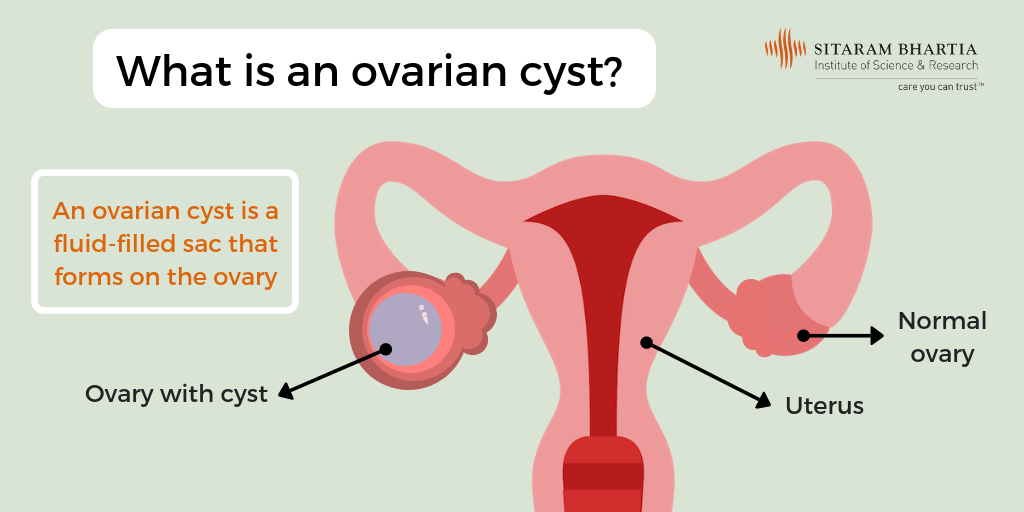Ovarian cyst is a fluid-filled sac that may form on one or both ovaries. The cysts can be of different types depending on their origin and the cells they contain. Most ovarian cysts, however, are benign and may not require treatment.

Ovarian Cyst Treatment
Ovarian cysts are fluid filled benign structures in ovary which require treatment in selected situations.
Ovarian cysts which are less than 4 cm and have clear fluid are usually functional and may come and go. In this case, you may not require ovarian cyst treatment.
All ovarian cysts which are persistent, are more than 5 cm, and have blood or chocolate coloured fluid will need treatment.
In some situations untreated ovarian cysts may lead to complications. Some large ovarian cysts can develop infection or undergo twist, leading to abdominal pain and may require surgery.
A laparoscopic procedure, known as ovarian cystectomy, is conducted where small cuts are made in the abdomen to remove the cysts. This minimally-invasive ovarian cyst surgery leaves little to no scars, results in a quicker recovery and is advised to remove ovarian cysts.
Ovarian cysts are rarely associated with cancer and if the doctor suspects malignancy, you will be advised surgery.
Ovarian Cyst and Pregnancy
At times, ovarian cysts form during pregnancy and resolve themselves by the early part of the second trimester without causing any issues.
Some ovarian cysts which rapidly enlarge during pregnancy or cause acute pain abdomen may necessitate a surgery. The best time to undergo a surgery in pregnancy is in the second trimester.
Keep in mind that there is nothing to worry about if you are diagnosed with ovarian cysts. Visit a gynecologist as soon as possible to understand the nature of the cyst and the optimal treatment required for your condition.Opt for early ovarian cyst treatment so that it does not affect your fertility and long term health.
Four different presentations of women having ovarian cysts who consulted Dr. Priti Arora Dhamija, Senior Gynecologist & Fertility Expert at Sitaram Bhartia Hospital are discussed in the following article.
1. Polycystic ovarian syndrome – Sanya’s Story
Sanya Kalra had been experiencing irregular periods since menarche (first menstrual cycle). At the age of 18, she started developing excessive hair growth on her face and legs.
Concerned, Sanya’s mother decided to take her daughter for a general checkup where she was advised an ultrasound.
Sanya’s ultrasound reports revealed a polycystic pattern in her ovaries. She thought she had developed an ovarian cyst and reported to the hospital.
“Does a polycystic ovary mean I have ovarian cysts?” asked a worried Sanya when she met Dr. Priti.
“Ovarian cyst is not similar to PCOS (Polycystic Ovary Syndrome) though the condition may seem related,” counseled Dr. Priti.
PCOS may lead to many immature eggs in your ovaries which have not ruptured. These immature eggs are fluid filled sacs which give the appearance of multiple or “poly” cysts.
“This condition is usually associated with mild hormonal imbalance and irregular periods due to irregular ovulation. It may also lead to excessive hair growth in certain areas of the body.”
The doctor urged Sanya to make certain lifestyle changes to manage her symptoms such as maintaining a fiber-rich diet and regular exercise.
“Avoiding weight gain also contributes to optimal hormonal levels, which would result in regular ovulation and periods.”
2. Ovarian Cyst in the Reproductive Age Group (25 – 35 years) – Reeta’s Story
When 25-year-old Reeta experienced acute abdominal pain one day, she was worried.
“At times, the pain was so unbearable I would even wake up from sleep. I didn’t want to take any chances so I decided to get it checked out immediately,” said Reeta.
At her initial ultrasound it was discovered that Meera had a large cyst on her right ovary.
“The cyst was 8 x 6 cm with clear fluid inside. Ovarian cysts may commonly form from the ruptured or unruptured egg (follicle). These are called functional cysts and do not usually grow beyond 3 to 4 cm,” recalled Dr. Priti.
Ovarian cysts usually regress in a few months but they may become a cause of concern if they grow like in Reeta’s case and induce symptoms such as:
- pelvic pain that ranges from a dull sensation to a sudden and sharp pain
- feeling of fullness or heaviness in abdomen
- a frequent urge to urinate
“Do large ovarian cysts need to be removed?” asked Reeta.
“We recommend ovarian cyst surgery if it becomes very large (>5 cm) or causes symptoms.”
If the appearance of large ovarian cysts also suggests solid areas within the cyst in the ultrasound, it may be potentially malignant and therefore require removal.
Reeta was urged to opt for surgical removal as soon as possible due to the cyst’s size.
“An ovarian cyst that is large can also cause complications such as ovarian torsion (where the enlarged cyst causes the ovary to twist painfully). The cyst can also rupture abruptly (ovarian cyst burst) and lead to emergency surgery.”
Reeta was worried if surgery for an ovarian cyst required the removal of her ovaries as well.
“It is possible to remove the cyst and preserve your reproductive system so that your fertility remains unaffected,” reassured Dr. Priti.
A laparoscopic procedure, known as ovarian cystectomy, is conducted where small cuts are made in the abdomen to remove the cysts. The minimally-invasive surgery leaves little to no scars and results in a quicker recovery.
Reeta realized putting off ovarian cyst treatment would cause more harm than good. She went ahead with the procedure and was back on her feet a few days after the surgery.
Satisfied with her decision, Reeta added in at a follow-up consultation, “Not only was I no longer suffering every day but was also able to go about my daily life normally!”
3. Ovarian Cyst during Menopause – Sulekha’s Story
When Sulekha Vashist, 40, was diagnosed with an ovarian cyst 3 years ago, she had decided to wait and re-examine her condition every few months.
Over the years, Sulekha’s cyst remained 3 cms in size so she chose to not receive conclusive treatment for her condition.
“One day, however, I came across an article that mentioned menopausal women have a higher chance of developing malignant ovarian cysts,” recalled Sulekha.
She decided to consult Dr. Priti immediately for a second opinion.
“What can happen if a cyst is left untreated?” she asked.
“In many cases, ovarian cysts that show no symptoms are observed using scans and tests as they can disappear before treatment is required. Sometimes, however, complications may occur,” answered Dr. Priti.
A repeat ultrasound scan showed some solid areas in Sulekha’s long standing ovarian cyst. Therefore a laparoscopic removal of ovarian cyst was recommended.
In some cases, a biopsy is conducted on the cyst laparoscopically on the OT table (frozen section) and if your doctor suspects malignant ovarian cysts or ovarian cancer then treatment is planned in the same sitting.
Unwilling to risk her health any longer, Sulekha chose to surgically remove her ovarian cyst so that a sample of the cyst could be sent for biopsy. She was relieved to hear that her suspicions were mistaken as the biopsy showed no signs of cancer.
“I am glad I got the cyst removed before any complications could occur,” said Sulekha at a follow-up consultation.
4. Endometriotic Cyst – Rekha’s Story
Rekha Wadhwani, 27, had been dismissing her pain during periods for many years as normal. Recently, she started experiencing pain even between her menstrual cycles and got worried.
“I had also been trying to conceive for a year and failing. I wondered if my abnormal period pain could be an indication of some underlying condition,” said Rekha.
Unwilling to ignore her health any longer, Rekha consulted Dr. Priti.
“Rekha’s ultrasound revealed she had developed endometriotic cysts 6 x 6 cms in size on both her ovaries,” said Dr. Priti.
“Caused by a chronic pelvic disease called endometriosis, endometriotic cysts develop due to a benign growth of endometrial cells in ovaries which resemble the inner lining of the uterus.”
When the inner lining of the uterus grows, these cells grow as well and cause severe pain.
Rekha was advised to undergo laparoscopic ovarian cystectomy and further hormonal treatment to not only control her condition but also help her conceive.
“For a while I thought that no relief for this condition existed and the pain would flare up during my periods. At the doctor’s advice, however, I realised treatment could provide significant respite and better chances to conceive,” said Rekha.
After her cyst was successfully removed surgically, Rekha was prescribed hormonal pills to elevate her symptoms and help her get pregnant.
“Even though there is no way to prevent ovarian cysts, regular pelvic examinations go a long way towards monitoring your reproductive health,” emphasized Dr. Priti.
It is important that you are aware of any abnormal changes that occur in your menstrual cycle. Don’t ignore your health and consult our doctors to clarify your doubts today!
Seek expert advice from Dr Priti. Please Chat with us on WhatsApp for appointments.
This blog post has been written with editorial inputs from Dr. Priti Arora Dhamija, who has over 17 years of experience as a Gynecologist.

Medically Reviewed by Dr. Priti Arora Dhamija
MBBS, Maulana Azad Medical College, Delhi (1999); M.D, Lady Hardinge Medical College (2004); DNB Obstetrics & Gynecology (2004); Diploma in Pelvic Endoscopy, Kiel, Germany (2014)



